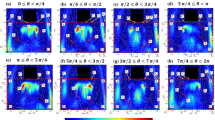Abstract
Measurements of skin friction have been performed on flat and hexagonal concave surfaces using the conventional Clauser-chart method and the Oil film interferometry. The values of shear stress coefficients measured by the conventional Clauser-chart method on a flat plate were found to be up to 13 % higher from the ones deduced by the Oil film interferometry. The velocity profiles required for the Clauser-chart were obtained by using hot wire anemometry. The analysis of the results suggested that the conventional Clauser-chart method cannot be used to predict shear stresses acting on the hexagonal concave surfaces due to the existence of strong pressure gradients. Oil film interferometry not only provides accurate and direct values of shear stress coefficients but also helps to visualize the flow above the surface.
Similar content being viewed by others
References
U. Butt, L. Jehring, and C. Egbers, Mechanism of drag reduction for circular cylinders with patterned surface, Int. J. Heat Fluid Flow, 2014, vol. 45, p. 128–134.
V.I. Kornilov and Yu.A. Litvinenko, Skin friction measurements in an incompressible turbulent boundary layer. Part 1. Adverse pressure gradient, Thermophysics and Aeromechanics, 2001, vol. 8, no. 4, p. 475–491.
V.C. Patel, Calibration of the Preston tube and limitations on its use in pressure gradients, J. Fluid Mech., 1965, vol. 23, p. 185–208.
F.H. Clauser, Turbulent boundary layers in adverse pressure gradients, J. Aeronaut. Sci., 1956, vol. 21, p. 91–108.
A. Sigalini, R. Örlü, and P.H. Alfredsson, Uncertainty analysis of von Karman constant, Exp. in Fluids, 2013, vol. 54, no. 2, p. 1460–1–1460–9.
S.J. Kline, W.C. Reynolds, F.A. Schraub, and P.W. Runstadler, The structure of turbulent boundary layers, J. Fluid Mech., 1967, vol. 30, p. 741–773.
R. Blackwelder and J. Haritonidis, Scaling of the bursting frequency in turbulent boundary layers, J. Fluid Mech., 1983, vol. 132, p. 87–103.
P. Spalart, Direct simulation of a turbulent boundary layer up to Reh = 1410, J. Fluid Mech., 1988, vol. 187, p. 61–98.
L. Ong and J.M. Wallace, Joint probability density analysis of the structure and dynamics of the vorticity field of a turbulent boundary layer, J. Fluid Mech., 1998, vol. 367, p. 291–328.
T. Wei, R. Schmidt, and P. McMurtry, Comment on the Clauser–chart method for determining the friction velocity, Exp. in Fluids, 2005, vol. 38, p. 695–699.
L.H. Tanner and L.G. Blows, A study of the motion of oil films on the surfaces in air flow, with application to the measurement of skin friction, J. Phys. E: Scientific Instruments, 1976, vol. 9, p. 194–202.
L.C. Squire, The motion of a thin oil sheet under the steady boundary layer on a body, J. Fluid Mech., 1961, vol. 11, p. 161–179.
H.H. Fernholz and G.S. Janke, New developments and applications of skin–friction measuring techniques, Meas. Sci. Technol., 1996, vol. 7, p. 1396–1409.
G. Pailhas, P. Barricau, Y. Touvet, and L. Perret, Friction measurement in zero and adverse pressure gradient boundary layer using oil droplet interferometric method, Exp. in Fluids, 2009, vol. 47, no. 2, p. 195–207.
H.C.H. Ng, I. Marusic, J.P. Monty, N. Hutchins, and M.S. Chong, Oil film interferometry in high Reynolds numbers turbulent boundary layers, in: 16th Australian Fluid Mechanics Conf., 2007, P. 807–814.
A.D. Shivsai and O.N. Ramesh, Determination of skin friction in strong pressure–gradient equilibrium and near–equilibrium turbulent boundary layers, Exp. in Fluids, 2009, vol. 47, no. 6, p. 1045–1058.
Author information
Authors and Affiliations
Corresponding author
Additional information
This work was conducted within the framework of a project ‘Destrukt’ funded and administered by the International Graduate School of Brandenburg University of Technology (BTU), Cottbus.
Rights and permissions
About this article
Cite this article
Butt, U., Egbers, C. Skin friction measurements on structured surfaces using Clauser-chart method and Oil film interferometry. Thermophys. Aeromech. 25, 367–377 (2018). https://doi.org/10.1134/S0869864318030058
Received:
Revised:
Published:
Issue Date:
DOI: https://doi.org/10.1134/S0869864318030058




